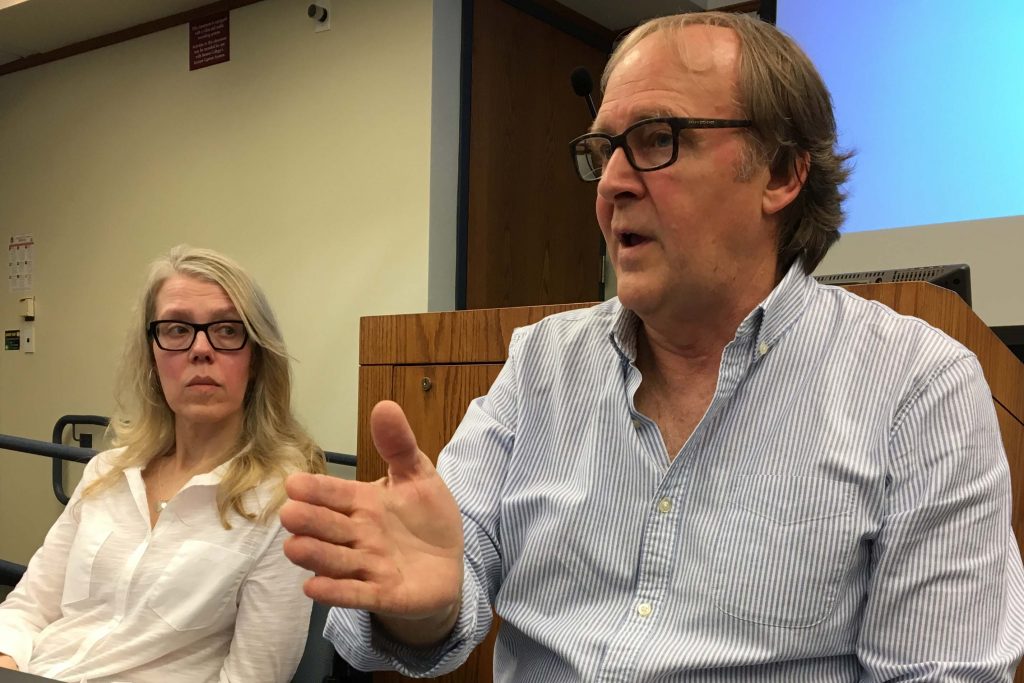Between them, husband and wife Fred Conrad and Tiina Loite spent nearly 75 years at the New York Times, he as a photographer, she mostly as a photo editor. On February 21, they came to BC Law with a rich trove of anecdotes chosen to illuminate where photojournalism and the law intersect. They touched on everything from restrictions on access and fair use of images to the impact of social media and moral responsibility.
Photographers and editors confront many hurdles on their way to getting a picture published. Conrad recalled photographing a scantily dressed young teenager at a Who concert for Rolling Stone magazine in his early freelance years only to be sued by the girl’s father after the photo was published. The man argued that because his daughter was a minor she was protected. The case went nowhere because of the public nature of the event, but it certainly awakened Conrad to the legal pitfalls of his profession.
Restricted access to news events, public figures, government facilities (e.g., prisons), and so on is a constant challenge, even for properly credentialed press photographers. “Everyone tries to control the imagery,” sometimes deviously, sometimes illegally, sometimes aggressively, sometimes bureaucratically, Conrad said. Situations like New York City Mayor Rudy Giuliani declaring the World Trade Center site a crime scene after the 9/11 attacks was understandable, (though it essentially forced news photographers to find creative ways to tell the story). In the event’s aftermath, however, the press confronted curious pushback on access to the cleanup. Accusations were subsequently made that the official delays were covering up looting by some of the workers, Conrad said.
One legacy of 9/11 has been “a more militarized and more aggressive” New York Police Department, Conrad said, a result of which has been rougher behavior towards the press and peaceful protestors, which he witnessed, for example, at Occupy Wall Street encounters.
Turning to the subject of everyday privacy, Loite said that, generally speaking, people don’t have a legal claim when in public spaces. And that extends to places like nightclubs and restaurants, so long as the facility has granted permission for the photographer to be there and the customers are made aware that pictures are being taken. That was the circumstance behind a club photo Loite published on the cover of the Times arts section, but it didn’t stop a man, depicted dancing with a woman who wasn’t his wife, from threatening legal action.
Things get even more complicated when stars like Beyoncé or Lady Gaga try to manipulate press coverage. Their control tactics have included banning professional photographers from their concerts and asking them to sign over the copyrights to their images. Conrad said that by calling out photography with which they are unhappy, such celebrities can become their own worst enemies and create what Conrad called “the Streisand effect.”
The name comes from a case that Barbra Streisand brought against an environmental photographer who published, on an obscure scientific website, an aerial photo of the California coast that circumstantially showed her house. When she sued, the photo went public and drew a million hits, Conrad said, generating much more publicity than was likely if she’d never complained. Streisand not only lost the case, she also had to pay the photographer’s legal fees.
Streisand isn’t the only one to grapple with social media’s power. It has upended conventional understanding of “fair use” of images, Loite said, and thrown photographers into the maelstrom of image copying, manipulation, reuse, and almost instantaneous dissemination—in many instances without their ability to exact permission or payment from the perpetrators.
In answer to a student’s question about a photojournalist’s moral responsibility in a situation where his or her subject may be in danger, Conrad cited something a friend once told him: “There’s a right way to do anything.”
Conrad and Loite are the parents of BC Law student Annika Conrad ’20. Their talk was sponsored by the Art Law Society at BC Law.


